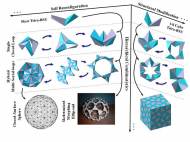Where art and technology meet – Kaleidogami and Kinetogami
 The Japanese art of paper folding Origami (from ori meaning “folding”, and kami meaning “paper”) inspired researchers from Purdue University to develop a method they named Kaleidogami – computational algorithms and tools used to turn a single sheet of paper into precisely folded morphing mechanisms. They also devised a variation of Kaleidogami named Kinetogami – method used to create robotic forms and shape-shifting sculptures.
The Japanese art of paper folding Origami (from ori meaning “folding”, and kami meaning “paper”) inspired researchers from Purdue University to develop a method they named Kaleidogami – computational algorithms and tools used to turn a single sheet of paper into precisely folded morphing mechanisms. They also devised a variation of Kaleidogami named Kinetogami – method used to create robotic forms and shape-shifting sculptures.
“Whereas traditional origami rules were committed such as when folding a square paper sheet without cutting or gluing, we create our structures by folding as well as making cuts to a single piece of flat paperlike materials”, said mechanical engineering doctoral student Wei Gao.
While Kaleidogami focuses on artistic representations of sculptural structures, Kinetogami is used to create foldable robot-like mechanisms. The robotic and artistic designs are made up of building blocks called Basic Structural Units (BSUs). Each BSU contains a pair of polyhedral components joined by a common creased hinge, and many BSUs are linked together to create complex structures such as a conceptualized morphing hexapod robot.
“The hexapod robotic form we proposed is able to adjust its body frequently in an adaptive manner to provide a wide range of gaits: lying down, flipping itself up, rising, squatting, squirming and slithering”, said Gao. “The folded designs have an elegant simplicity, while using paper and cardboard-like materials that are flat is practical because they are very inexpensive and lightweight.”
Aside potential use for morphing robots, the method could be applied in architecture to design new and interesting vaulted ceilings, skylights and retractable roofs. The researchers have created paper models of the designs and are looking into using a variety of systems that are suitable to power these structures. The transformation ability of these materials also simplifies shipping since items created with mentioned methods could be transported as a flat sheet of material.
The researchers plan to explore collaborations with museums to incorporate kinetic art in exhibits. Aside artwork, robots, toys and architectural elements, Purdue School of Mechanical Engineering researchers envision their method could be used in educational applications, where these transforming objects could aid in more practical and fun way to teach spatial geometry, kinematics and mechanics.
“Scientists and engineers are often motivated by the beauty of artistic representations while artists and architectural designers want to harness concepts from science, technology, engineering and mathematics. One of our aims is to provide a new geometry-inspired art form, reconfigurable structures, in the emerging field of kinetic art”, said Karthik Ramani, Purdue University’s Donald W. Feddersen Professor of Mechanical Engineering.









The only good robot is a wet robot! :)
So… how about the longevity of these creations? I believe it isn’t very long.